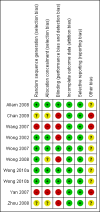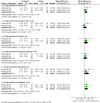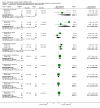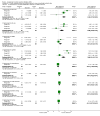Acupuncture for autism spectrum disorders (ASD)
- PMID: 21901712
- PMCID: PMC8939294
- DOI: 10.1002/14651858.CD007849.pub2
Acupuncture for autism spectrum disorders (ASD)
Abstract
Background: Autism spectrum disorders (ASD) are characterized by impairment in social interaction, impairment in communication and lack of flexibility of thought and behavior. Acupuncture, which involves the use of needles or pressure to specific points on the body, is used widely in Traditional Chinese Medicine and increasingly within a western medical paradigm. It has sometimes been used as a treatment aimed at improving ASD symptoms and outcomes, but its clinical effectiveness and safety has not been rigorously reviewed.
Objectives: To determine the effectiveness of acupuncture for people with ASD in improving core autistic features, as well as communication, cognition, overall functioning and quality of life, and to establish if it has any adverse effects.
Search strategy: We searched the following databases on 30 September 2010: CENTRAL (The Cochrane Library, 2010, Issue 3), MEDLINE (1950 to September 2010 Week 2), EMBASE (1980 to 2010 Week 38), PsycINFO, CINAHL, China Journal Full-text Database, China Master Theses Full-text Database, China Doctor Dissertation Full-text Database, China Proceedings of Conference Database, Index to Taiwan Periodical Literature System, metaRegister of Controlled Trials and the Chinese Clinical Trials Registry. We also searched AMED (26 February 2009) and Dissertation Abstracts International (3 March 2009), but these were no longer available to the authors or editorial base at the date of the most recent search. TCMLARS (Traditional Chinese Medical Literature Analysis and Retrieval System) was last searched on 3 March 2009.
Selection criteria: We included randomized and quasi-randomized controlled trials. We included studies comparing an acupuncture group with at least one control group that used no treatment, placebo or sham acupuncture treatment in people with ASD. We excluded trials that compared different forms of acupuncture or compared acupuncture with another treatment.
Data collection and analysis: Two review authors independently extracted trial data and assessed the risk of bias in the trials. We used relative risk (RR) for dichotomous data and mean difference (MD) for continuous data.
Main results: We included 10 trials that involved 390 children with ASD. The age range was three to 18 years and the treatment duration ranged from four weeks to nine months. The studies were carried out in Hong Kong, mainland China and Egypt.Two trials compared needle acupuncture with sham acupuncture and found no difference in the primary outcome of core autistic features (RFRLRS total score: MD 0.09; 95% CI -0.03 to 0.21, P = 0.16), although results suggested needle acupuncture might be associated with improvement in some aspects of the secondary outcomes of communication and linguistic ability, cognitive function and global functioning.Six trials compared needle acupuncture plus conventional treatment with conventional treatment alone. The trials used different primary outcome measures and most could not demonstrate effectiveness of acupuncture in improving core autistic features in general, though one trial reported patients in the acupuncture group were more likely to have improvement on the Autism Behavior Checklist (RR 1.53; 95% CI 1.09 to 2.16, P = 0.02) and had slightly better post-treatment total scores (MD -5.53; 95% CI -10.76 to -0.31, P = 0.04). There was no evidence that acupuncture was effective for the secondary outcome of communication and linguistic ability, though there seemed to be some benefit for the secondary outcomes of cognitive function and global functioning.Two trials compared acupressure plus conventional treatment with conventional treatment alone and did not report on the primary outcome. Individual study results suggested there may be some benefit from acupressure for certain aspects of the secondary outcomes of communication and linguistic ability, cognitive function and global functioning.Four trials reported some adverse effects, though there was little quantitative information, and at times both intervention and control groups experienced them. Adverse effects noted included bleeding, crying due to fear or pain, irritability, sleep disturbance and increased hyperactivity. None of the trials reported on quality of life.There are a number of problems with the evidence base: the trials were few in number and included only children; six of the trials were at high risk of bias; they were heterogeneous in terms of participants and intervention; they were of short duration and follow-up; they reported inconsistent and imprecise results, and, due to carrying out large numbers of analyses, they were at risk of false positivity.
Authors' conclusions: Current evidence does not support the use of acupuncture for treatment of ASD. There is no conclusive evidence that acupuncture is effective for treatment of ASD in children and no RCTs have been carried out with adults. Further high quality trials of larger size and longer follow-up are needed.
Conflict of interest statement
Daniel KL Cheuk ‐ none known.
Virginia Wong and Wen Xiong Chen were involved in a funded project on 'Integration of Traditional Chinese Medicine (Acupuncture) in Interventional Program of Children with Autistic Spectrum Disorder (or Autism)' with Tung Wah Group of Hospitals locally in Hong Kong that was performed from 2004‐2007. Paper published: WX Chen, WL Liu, V Wong. Electroacupuncture for Children with Autism Spectrum Disorder. Pilot study of 2 cases. The Journal of Alternative and Complementary Medicine 14(8); 1057‐1‐65, 2008.
Figures



































Update of
- doi: 10.1002/14651858.CD007849
References
References to studies included in this review
Allam 2008 {published data only}
-
- Allam H, Eldine NG, Helmy G. Scalp acupuncture effect on language development in children with autism: a pilot study. Journal of Alternative and Complementary Medicine 2008;14(2):109‐14. - PubMed
Chan 2009 {published data only}
-
- Chan AS, Cheung M, Sze SL, Leung WW. Seven‐star needle stimulation improves language and social interaction of children with autistic spectrum disorders. American Journal of Chinese Medicine 2009;37(3):495‐504. - PubMed
Wang 2007 {published data only}
-
- Wang CN, Liu Y, Wei XH, Li LX. Effects of electroacupuncture combined with behavior therapy on intelligence and behavior of children of autism [Dian Zhen Pei He Xing Wei Liao Fa Dui Gu Du Zheng Huan Er Xing Wei Neng Li Ji Zhi Neng De Ying Xiang]. Chinese Acupuncture & Moxibustion 2007;27(9):660‐2. - PubMed
-
- Wang CN, Shang SY, Wei XH. The influence of electroacupuncture plus behavior therapy on social behavior ability in autism children [Dian Zhen Pei He Xing Wei Liao Fa Dui Gu Du Zheng She Hui Shi Ying Xing Wei Neng Li De Ying Xiang]. Shanghai Journal of Acupuncture and Moxibustion 2006;25(12):19‐20.
Wong 2002 {published and unpublished data}
-
- Wong V, Sun JG. Research on tongue acupuncture in children with autism. The 9th International Child Neurology Congress & The 7th Asian & Oceanian Congress of Child Neurology. 2002.
Wong 2007 {unpublished data only}
-
- Wong V, Sun JG, Yeung DWC. Randomized controlled trial of using tongue acupuncture in autism spectrum disorder using PET scan for clinical correlation. Unpublished manuscript.
Wong 2008 {published and unpublished data}
-
- Wong CL. Acupuncture and autism spectrum disorders ‐ an assessor‐blinded randomized controlled trial (M Phil). Hong Kong: University of Hong Kong, 2008.
Wong 2010a {published and unpublished data}
-
- Wong VC, Sun JG. Randomized controlled trial of acupuncture versus sham acupuncture in autism spectrum disorder. Journal of Alternative and Complementary Medicine 2010;16(5):545‐53. - PubMed
Wong 2010b {published and unpublished data}
-
- Wong VCN, Chen WX. Randomized controlled trial of electro‐acupuncture for autism spectrum disorder. Alternative Medicine Review 2010;15(2):136‐46. - PubMed
Yan 2007 {published data only}
-
- Yan Y, Wei Y, Chen Y, Chen M. Effect acupuncture on rehabilitation training of child's autism. Chinese Acupuncture & Moxibustion 2007;27(7):503‐5. - PubMed
Zhou 2008 {published data only}
-
- Zhou H, Zhang P. The effect of language therapy combined with point massage on communication disability in autism children. China Practical Medical 2008;3(23):24‐6.
References to studies excluded from this review
Liu 2008 {published data only}
-
- Liu G, Yuan LX. Acupuncture for autistic children: clinical research [Zhen Ci Zhi Liao Er Tong Zi Bi Zheng Lin Chuang Yan Jiu]. Liaoning Journal of Traditional Chinese Medicine 2008;35(2):273‐4.
-
- Liu G, Yuan LX. Clinical observe of acupuncture treat autism. Chinese Archives of Traditional Chinese Medicine 2007;25(12):2497‐8.
Ma 2006 {published data only}
-
- Ma RL, Yang Q, Jin R. Effect of acupuncture combined behavior intervention on children with autism [Zhen Ci Pei He Xing Wei Gan Yu Liao Fa Dui Er Tong Zi Bi Zheng Xing Wei De Ying Xiang]. Chinese Journal of Integrated Traditional and Western Medicine 2006;26(5):419‐22. - PubMed
Wu 2008 {published data only}
-
- Wu ZF. The clinical applied research with JIN's 3‐needle therapy in treating autism children (MA). Guangzhou: University of Chinese Medicine, 2008.
Yuan 2007 {published data only}
-
- Yuan Q, Chai T, Lang JY, Wang RC, Wu ZF. Effect of acupuncture for autism in children: an observation of 40 cases. Journal of Guangzhou University of Traditional Chinese Medicine 2007;24(3):208‐14.
Yuan 2009a {published data only}
-
- Yuan Q, Wang RC, Wu ZF, Zhao Y, Bao XJ, Jin R. Observation on clinical therapeutic effect of JIN's 3‐needling therapy on severe autism [Jin San Zhen Zhi Liao Zhong Du Zi Bi Zheng Liao Xiao Dui Zhao Guan Cha]. Chinese Acupuncture & Moxibustion 2009;29(3):177‐80. - PubMed
Yuan 2009b {published data only}
-
- Yuan Q, Wu ZF, Wang RC, Liu G, Bao XJ, Lang JY. Analysis of therapeutic effect of Jin's three‐needling therapy on children autism with different TCM syndrome types [Jin San Zhen Zhi Liao Er Tong Zi Bi Zheng Bu Tong Zhong Yi Zheng Xing Liao Xiao Fen Xi]. Journal of Guangzhou University of Tranditional Chinese Medicine 2009;26(3):241‐4.
-
- Yuan Q, Wu ZF, Wang RC, Zhao Y, LangJY. Therapeutic effect of acupuncture on clinical symptoms in autistic children. Journal of New Chinese Medicine 2009;41(3):83‐5.
-
- Yuan, Q, Wu ZF, Wang RC, Deng JJ, Zhou HL, Lang JY. Observation on the therapeutic effect of acupuncture treatment of autism children [Zhen Ci Dui Bu Tong Bing Qinq Cheng Du Er Tong Zi Bi Zheng Liao Xiao Fen Xi]. Acupuncture Research 2009;34(3):183‐7. - PubMed
Zhang 2005 {published data only}
-
- Zhang Q. Clinical and experimental research on acupuncture for autistic children with language disorder. Guangzhou: University of Chinese Medicine, 2001.
-
- Zhang Q, Jin R. Clinical research on acupuncture treatment of aphasia in autism children. World Journal of Acupuncture‐Moxibustion 2005;15(4):19‐22.
-
- Zhang Q, Yu R, Pang J, Zhou Y, Zhou Y, Jin R. Acupuncture induced changes of the event related potential P3 latency and wave amplitude in autistic children with language disorder. Chinese Journal of Clinical Rehabilitation 2005;9(20):10‐1.
-
- Zhang Q, Yu R, Pang J, Zhou Y, Zhou Y, Jin R. Effect of acupuncture in improving intelligence and language disorder of autistic children. Chinese Journal of Clinical Rehabilitation 2005;9(28):112‐3.
Additional references
AAP 2001
-
- Committee on Children with Disabilities. Counseling families who choose complementary and alternative medicine for their child with chronic illness or disability. Pediatrics 2001;107(3):598‐601. - PubMed
Ahn 2005
Aman 1986
-
- Aman M, Singh N. Aberrant Behaviour Checklist: Manual. New York: Slosson Educational Publications, 1986.
APA 2000
-
- American Psychiatric Association. Diagnostic and Statistical Manual of Mental Disorders DSM‐IV‐TR Fourth Edition (Text Revision). American Psychiatric Association, 2000.
Araghi‐Niknam 2003
Baird 2006
-
- Baird G, Simonoff E, Pickles A, Chandler S, Loucas T, Meldrum D, et al. Prevalence of disorders of the autism spectrum in a population cohort of children in South Thames: the Special Needs and Autism Project (SNAP). Lancet 2006;368(9531):210‐5. - PubMed
Bryson 2003
-
- Bryson SE, Rogers SJ, Fombonne E. Autism spectrum disorders: early detection, intervention, education, and psychopharmacological management. Canadian Journal of Psychiatry 2003;48(8):506‐16. - PubMed
Buehler 2011
-
- Buehler MR. A proposed mechanism for autism: an aberrant neuroimmune response manifested as a psychiatric disorder. Medical Hypotheses 2011;76:863‐70. - PubMed
Burd 1987
-
- Burd L, Fisher W, Kerbeshian J. A prevalence study of pervasive developmental disorders in North Dakota. Journal of American Academy of Child and Adolescent Psychiatry 1987;26(5):700‐3. - PubMed
Carlson 2011
Chao 2010
Chauhan 2006
-
- Chauhan A, Chauhan V. Oxidative stress in autism. Pathophysiology 2006;13(3):171‐81. - PubMed
Chen 2008
-
- Chen WX, WL Liu, Wong VC. Electroacupuncture for children with autism spectrum disorder: pilot study of 2 cases. Journal of Alternative and Complementary Medicine 2008;14(8):1057‐65. - PubMed
Correia 2010
-
- Correia CT, Coutinho AM, Sequeira AF, Sousa IG, Lourenço Venda L, Almeida JP, et al. Increased BDNF levels and NTRK2 gene association suggest a disruption of BDNF/TrkB signaling in autism. Genes Brain and Behaviour 2010;9(7):841‐8. - PubMed
Dung 1984
-
- Dung HC. Anatomical features which contribute to the formation of acupuncture points. American Journal of Acupuncture 1984;12:139‐44.
Dunn 1961
-
- Dunn HL. High‐Level Wellness. Arlington, VA: Beatty Press, 1961.
Edwards 1997
-
- Edwards S, Fletcher P, Garman M, Hughes A, Letts C, Sinka I. The Reynell Developmental Language Scales III. Windsor: NFER‐Nelson, 1997.
Elbourne 2002
-
- Elbourne DR, Altman DG, Higgins JPT, Curtin F, Worthington HV, Vail A. Meta‐analyses involving cross‐over trials: methodological issues. International Journal of Epidemiology 2002;31(1):140‐9. - PubMed
Ernst 2001
-
- Ernst E, White AR. Prospective studies of the safety of acupuncture: a systematic review. American Journal of Medicine 2001;110:481‐5. - PubMed
Faras 2010
Folstein 1991
-
- Folstein SE, Piven J. Etiology of autism: genetic influences. Pediatrics 1991;87(5 Pt 2):767‐73. - PubMed
Freeman 1986
-
- Freeman BJ, Ritvo ER, Yokota A, Ritvo A. A scale for rating symptoms of patients with the syndrome of autism in real life settings. Journal of the American Academy of Child and Adolescent Psychiatry 1986;25(1):130‐6. - PubMed
Fu 2000
-
- Fu H. What is the material base of acupuncture? The nerves!. Medical Hypotheses 2000;54(3):358‐9. - PubMed
Fu 2009
Furlan 2005
Godlee 2011
-
- Godlee F, Smith J, Marcovitch H. Wakefield's article linking MMR vaccine and autism was fraudulent. British Medical Journal 2011;342:c7452. - PubMed
Griffiths 1996
-
- Griffiths R, Huntley M. The Griffiths Mental Development Scales: From Birth to 2 Years. Henley‐on‐Thames, UK: Test Agency Ltd, 1996.
Gringras 2000
-
- Gringras P. Practical paediatric psychopharmacological prescribing in autism. Autism 2000;4(3):229‐47.
Haley 1992
-
- Haley SM, Coster WJ, Ludlow LH, Haltiwanger JT, Andrellos PJ. Pediatric Evaluation of Disability Inventory (PEDI). San Antonio TX: Pearson, 1992.
Hanson 2007
-
- Hanson E, Kalish LA, Bunce E, Curtis C, McDaniel S, Ware J, et al. Use of complementary and alternative medicine among children diagnosed with autism spectrum disorder. Journal of Autism and Developmental Disorders 2007;37(4):628‐36. - PubMed
Harrington 2006
-
- Harrington JW, Rosen L, Garnecho A, Patrick PA. Parental perceptions and use of complementary and alternative medicine practices for children with autistic spectrum disorders in private practice. Journal of Developmental and Behavioral Pediatrics 2006;27(2 Suppl):S156‐61. - PubMed
Helms 2007
-
- Helms JM. Acupuncture energetics: a clinical approach for physicians. Stuttgart: Thieme Publishing Group, 2007.
Higgins 2011
-
- Higgins JPT, Green S. Cochrane Handbook for Systematic Reviews of Interventions Version 5.1.0 [updated March 2011]. Chichester, UK: The Cochrane Collaboration, 2011. Available from www.cochrane‐handbook.org.
Jansen 1989
-
- Jansen G, Lundeberg T, Kjartansson S, Samuelson UE. Acupuncture and sensory neuropeptides increase cutaneous blood flow in rats. Neuroscience Letters 1989;97:305‐9. - PubMed
Johansson 1993
-
- Johansson K, Lindgren I, Widner H. Can sensory stimulation improve the functional outcome in stroke patients. Neurology 1993;43:2189‐92. - PubMed
Kim 2010
-
- Kim SK, Bae H. Acupuncture and immune modulation. Autonomic Neuroscience: Basic and Clinical 2010;157:38‐41. - PubMed
Lee 2010
-
- Lee GJ, Yin CS, Choi SK, Choi S, Yang JS, Lee H, et al. Acupuncture attenuates extracellular glutamate level in global ischemia model of rat. Neurology Research 2010;Suppl 1:79‐83. - PubMed
Leiter 1980
-
- Leiter 1980. Leiter International Performance Scale Instruction manual. Revised. Wood Dale, IL: Stoelting, 1980.
Leung 2009
-
- Leung PC, Zhang L, Cheng KF. Acupuncture: Complications are preventable not adverse events. Chinese Journal of Integrative Medicine 2009;15(3):229‐32. - PubMed
Levy 2003
-
- Levy SE, Mandell DS, Merhar S, Ittenbach RF, Pinto‐Martin JA. Use of complementary and alternative medicine among children recently diagnosed with autistic spectrum disorder. Journal of Developmental and Behavioral Pediatrics 2003;24(6):418‐23. - PubMed
Leyfer 2006
-
- Leyfer OT, Folstein SE, Bacalman S, Davis NO, Dinh E, Morgan J, et al. Comorbid psychiatric disorders in children with autism: interview development and rates of disorders. Journal of Autism and Developmental Disorders 2006;36(7):849‐61. - PubMed
Li 2009
-
- Li J, Liu JM, Liu XQ, Liang FX, Wang H. Influence on electroacupuncture at "Qiangzhuang" acupoints for neuro‐immune regulation of sub‐acute aged rats. Chinese Acupuncture and Moxibustion 2009;29(11):905‐9. - PubMed
Lin 2008
-
- Lin JG, Chen WL. Acupuncture analgesia: a review of its mechanisms of actions. American Journal of Chinese Medicine 2008;36(4):635‐45. - PubMed
Liu 2004
-
- Liu JH, Yan J, Yi SX, Chang XR, Lin YP, Hu JM. Effects of electroacupuncture on gastric myoelectric activity and substance P in the dorsal vagal complex of rats. Neuroscience Letters 2004;356(2):99‐102. - PubMed
Lord 1994
-
- Lord C, Rutter M, Couteur A. Autism Diagnostic Interview‐Revised: a revised version of a diagnostic interview for caregivers of individuals with possible pervasive developmental disorders. Journal of Autism & Developmental Disorders 1994;24:659‐85. - PubMed
Lord 1997
-
- Lord C, Rutter M, DiLavore PC. Autism Diagnostic Observation Scale ‐ Generic. Chicago, IL: University of Chicago Press, 1997.
Lowe 1976
-
- Lowe M, Costello AJ. Manual for the symbolic play test. Windsor: National Foundation for Educational Research, 1976.
Maciocia 1989
-
- Maciocia G. Foundations of Chinese Medicine: A comprehensive Text for Acupuncturists and Herbalists. Edinburgh: Churchill Livingstone, 1989.
Madsen 2002
-
- Madsen KM, Hviid A, Vestergaard M, Schendel D, Wohlfahrt J, Thorsen P, et al. A population‐based study of measles, mumps, and rubella vaccination and autism. New England Journal of Medicine 2002;347:1477‐82. - PubMed
Magnusson 1994
-
- Magnusson M, Johansson K, Johansson BB. Sensory stimulation promotes normalization of postural control after stroke. Stroke 1994;25:1176‐80. - PubMed
Manni 2010
-
- Manni L, Albanesi M, Guaragna M, Barbaro Paparo S, Aloe L. Neurotrophins and acupuncture. Autonomic Neuroscience: Basic and Clinical 2010;157:9‐17. - PubMed
Middlekauff 2004
-
- Middlekauff HR, Shah JB, Yu JL, Hui K. Acupuncture effects on autonomic responses to cold pressor and handgrip exercise in healthy humans. Clinical Autonomic Research 2004;12(2):113‐8. - PubMed
Moazzami 2010
Msall 1994
-
- Msall ME, DiGaudio K, Rogers BT, LaForest S, Catanzaro NL, Campbell J, et al. The functional independence measure for children (WeeFIM). Conceptual basis and pilot use in children with developmental disabilities. Clinical Pediatrics 1994;33:421‐30. - PubMed
Muhle 2004
-
- Muhle R, Trentacoste SV, Rapin I. The genetics of autism. Pediatrics 2004;113(5):e472‐86. - PubMed
NIH 1998
-
- NIH Consensus Conference. Acupuncture. JAMA 1998;280:1518‐24. - PubMed
Posey 2001
-
- Posey DJ, McDougle CJ. Pharmacotherapeutic management of autism. Expert Opinion on Pharmacotherapy 2001;2(4):587‐600. - PubMed
Rapin 2008
-
- Rapin I, Tuchman RF. What is new in autism?. Current Opinion in Neurology 2008;21(2):143‐9. - PubMed
RevMan 2011 [Computer program]
-
- The Cochrane Collaboration. Review Manager (RevMan). Version 5.1. Copenhagen: The Nordic Cochrane Centre: The Cochrane Collaboration, 2011.
Rimland 1999
-
- Rimland B, Edelson SM. Autism Treatment Evaluation Checklist (ATEC). Available online: http://www.autism.com/ari/atec/atec‐online.htm 1999.
Rossignol 2009
-
- Rossignol DA. Novel and emerging treatments for autism spectrum disorders: a systematic review. Annals of Clinical Psychiatry 2009;21(4):213‐36. - PubMed
Sajdel‐Sulkowska 2009
-
- Sajdel‐Sulkowska EM, Xu M. Increase in cerebellar neurotrophin‐3 and oxidative stress markers in autism. Cerebellum 2009;8:366‐72. - PubMed
SCSSS 1999
-
- Swedish Collaberation on Sensory Stimulation in Stroke. Sensory stimulation after stroke: a randomized controlled trial. Cerebrovascular Diseases 1999;9(Suppl 11):28.
Sheikh 2010a
-
- Sheikh AM, Malik M, Wen G, Chauhan A, Chauhan V, Gong CX, et al. BDNF‐Akt‐Bcl2 antiapoptotic signaling pathway is compromised in the brain of autistic subjects. Journal of Neuroscience Research 2010;88:2641‐7. - PubMed
Sheikh 2010b
-
- Sheikh AM, Li X, Wen G, Tauqeer Z, Brown WT, Malik M. Cathepsin D and apoptosis related proteins are elevated in the brain of autistic subjects. Neuroscience 2010;165:363‐70. - PubMed
Skuse 2004
-
- Skuse D, Warrington R, Bishop D, Chowdhury U, Lau J, Mandy W, et al. The developmental, dimensional and diagnostic interview (3di): a novel computerized assessment for autism spectrum disorders. Journal of the American Academy of Child and Adolescent Psychiatry 2004;43:548‐58. - PubMed
Stux 1998
-
- Stux G, Pomeranz B. Chapter 2 ‐ Scientific Basis of Acupuncture. Basics of Acupuncture. 4th Edition. New York: Springer, 1998:6‐23.
Sun 2001
-
- Sun HL, Li XM. Clinical study on treatment of cerebral apoplexy with penetration needling of scalp acupoints [Tou xue tou ci zhi liao nao zu zhong lin chuang yan jiu]. Chinese Acupuncuture and Moxibustion 2001;21(5):275‐8.
Taylor 2002
Wakefield 1998
-
- Wakefield AJ, Murch SH, Anthony A, Linnell J, Casson DM, Malik M, et al. Ileal‐lymphoid‐nodular hyperplasia, non‐specific colitis, and pervasive developmental disorder in children. Lancet 1998;351:637‐41. - PubMed
Wang 2009
-
- Wang Q, Peng Y, Chen S, Gou X, Hu B, Du J, et al. Pretreatment with electroacupuncture induces rapid tolerance to focal cerebral ischemia through regulation of endocannabinoid system. Stroke 2009;40:2157‐64. - PubMed
Wang 2011
WHO 1992
-
- World Health Organization. International Statistical Classification of Diseases and Related Health Problem, Tenth Revision. Geneva: World Health Organization, 1992.
WHO 1993
-
- World Health Organization. WHOQoL Study Protocol. WHO (MNH7PSF/93.9). Geneva: WHO, 1993.
Williams 2008
-
- Williams E, Thomas K, Sidebotham H, Emond A. Prevalence and characteristics of autistic spectrum disorders in the ALSPAC cohort. Developmental Medicine and Child Neurology 2008;50(9):672‐7. - PubMed
Wing 1997
-
- Wing L, Leekam SR, Libby SJ, Gould J, Larcombe M. The diagnostic interview for social and communication disorders: background, inter‐rater reliability and clinical use. Journal of Child Psychology and Psychiatry 2002;43:307‐25. - PubMed
Wing 1999
-
- Wing L. Diagnostic Interview for Social and Communication Disorders (DISCO). 10. Kent: The National Autistic Society, 1999.
Wong 2006a
-
- Wong HH, Smith RG. Patterns of complementary and alternative medical therapy use in children diagnosed with autism spectrum disorders. Journal of Autism and Developmental Disorders 2006;36(7):901‐9. - PubMed
Wong 2006b
-
- Wong HH, Smith RG. Patterns of complementary and alternative medical therapy use in children diagnosed with autism spectrum disorders. Journal of Autism and Development Disorders 2006;36(7):901‐9. - PubMed
Wong 2009
-
- Wong VC. Use of Complementary and Alternative Medicine (CAM) in Autism Spectrum Disorder (ASD): Comparison of Chinese and Western Culture (Part A). Journal of Autism and Developmental Disorders 2009;39(3):454‐3. - PubMed
Wong 2010
-
- Wong FW, Lim CE, Smith W. A new bioimpedance research device (BIRD) for measuring the electrical impedance of acupuncture meridians. Journal of Alternative and Complementary Medicine 2010;16(3):257‐64. - PubMed
Wu 1996
-
- Wu JN. A short history of acupuncture. Journal of Alternative and Complementary Medicine 1996;2:19‐21. - PubMed
Yang 2010
-
- Yang EJ, Jiang JH, Lee SM, Hwang HS, Lee MS, Choi SM. Electroacupuncture reduces neuroinflammatory responses in symptomatic amyotrophic lateral sclerosis model. Journal of Neuroimmunology 2010;223:84‐91. - PubMed
Yoon 2010
-
- Yoon SS, Kim H, Choi KH, Lee BH, Lee YK, Lim SC, et al. Acupuncture suppresses morphine self administration through the GABA receptors. Brain Research Bulletin 2010;81:625‐30. - PubMed
Young 2011
Zhang 2008
-
- Zhang HZ, Zhang LX, She YF, Li WL, Zhang XJ, Zhang RJ. Effect of electroacupuncture on apoptosis of hippocampus tissue in mice with vascular dementia. Acupuncture Research 2008;33(6):377‐81. - PubMed
Publication types
MeSH terms
LinkOut - more resources
Full Text Sources
Medical

